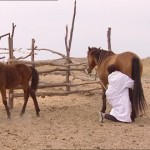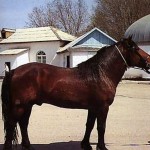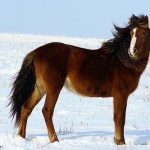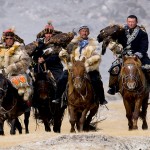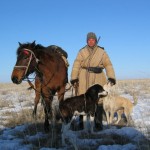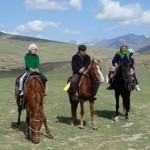Kazakh Horse
The Kazakh Horse is a breed of horses that evolved in Kazakhstan. All the year round, these horses are kept in the pastures for browsing or grazing. Mainly concentrated in the western region of the country, these horses are used for various purposes like riding, milk production and even for meat, which is a very common part of the culture and traditional diet of the Kazakhstanis. Although this is an exceptionally hardy breed, they are not much known for performance because of their short strides which often makes the ride choppy.
Kazakh Horse Pictures
- Kazakh Horse Foal
- Kazakh Horse Images
- Kazakh Horse Pictures
- Kazakh Horse
- Kazakh Horsemen
- Kazakh Horses
- Kazakh Horse Stallion
- Kazakh Horses Pictures
Quick Information
| Other Names/Nicknames | Kazakh |
| Behavioral Characteristics | Multi-talented, loyal, intelligent, obedient, easily trainable, retains influence of high energy bloodlines |
| Physical Descriptions | They have a straight back, stout croup, correctly-set legs, heavy head, thick, short neck, and deep chest |
| Colors | Gray, palomino, brown, grullo |
| Common Uses | General riding, work, racing, endurance (trekking, etc.) |
| Lifespan/Expectancy | 25-30 years average |
| Weight | 400-500 Kilos |
| Height (size) | Stallions: 14.0 1⁄2 hands; Mares: 14 hands |
| Health Problems | Generally healthy, with no breed-specific ailments |
| Movements | Criticized for short stride and jolting trot, but can well travel long distances |
| Blood Type | Warm-blooded |
| Ancestors | Asiatic Wild Horse, Mongolian Horse, Karabair Horse, Arabian Horse, Akhal-Teke |
| Popular Traits | Strong and hardy, multi-talented, easily maintainable, easy keeper, great endurance |
| Feeding/Diet | General horse diets consisting of hay, grass, grains, vegetables, etc. |
| Country of Origin | Kazakhstan |
| Year/Time of Development | 5th Century BC |
Video: Kazakh Horse
History and Development
Though the modern Kazakh horse looks like a more refined version of the Mongolian Horse, this was not always the case. The Kazakhs date back to the 5th century B. C., and before domestication, they initially evolved as a breed of native wild horses. However, other breeds like the Mongolian Horse, the Karabair Horse, the Arabian Horse & the Akhal-Teke Horse, all had their influences upon the Kazakh breed right from the time they had evolved.
The Kazakh horses are also found in some parts of Russia and China, with a few physical differences. Though, both the Russian and Chinese herds evolved from the same stock. Based on different ecological factors of the vast territory they dwelled in, these horses have become differentiated into several varieties and types, with the Jabe or Dzhab, and the Adaev being the most common.
Type Jabes developed in the southern districts of the region of Aktubinsk, after which they widely spread throughout the country. They are a kind of a rugged variety with heads not well-defined, and having a broad neck, The Adaevs, Their most important characteristics are: rugged head, deep chest, thick neck, and a wide body, unlike the Adaev, that rather has a defined, saddle character and well-pronounced features.
From the 20th century, the breed met with additional blood infusion from other horse breeds like the Russian Don, the Orlov Trotter, and the Thoroughbred. Kazakh tribesmen, the once nomadic wanderers, still breed the Kazakh horse despite the fact that, the traditional bloodlines have been diluted by cross-breeding.
Interesting Facts
- Record has it that the horses did 297 km during a daily run.
- Among the horsemeat eaters, these horses are known for their good meat characteristics. At slaughter, about 57-60% of meat can be yielded.
- The best farm for the Kazakh horses is the Mugojar stud.
- The Kazakh breed numbers over 300,000.


